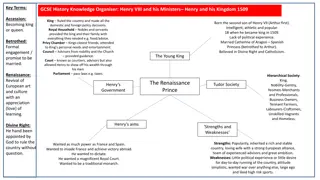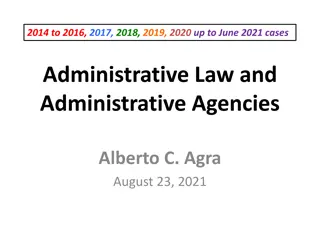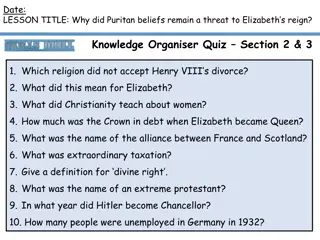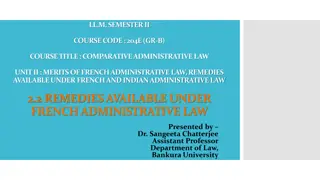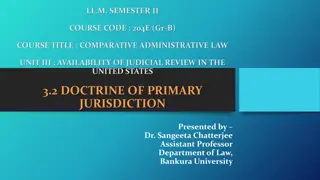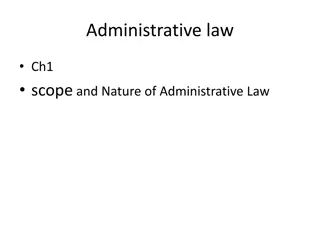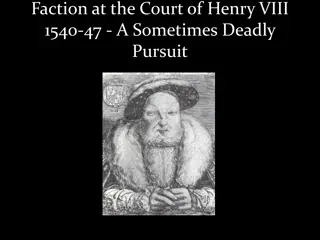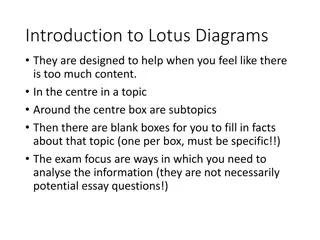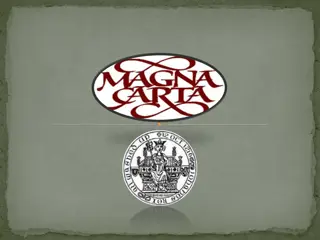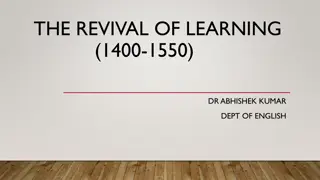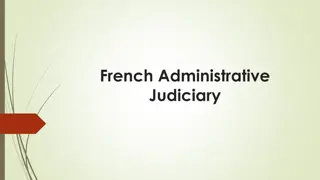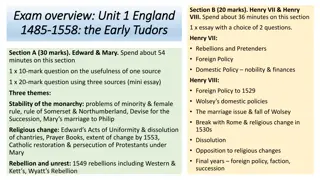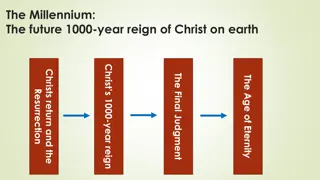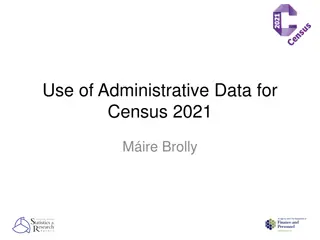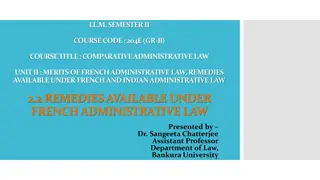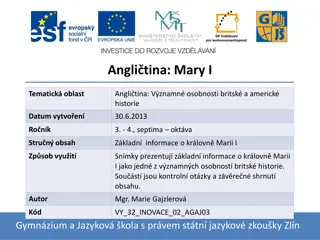Exploring Henry II's Reign: Administrative and Legal Changes
The lecture delves into the reign of Henry II, highlighting key events, motivations for changes, administrative reforms, and changes in legal remedies. It covers topics such as the conflict between regnum and sacerdotium, motivations behind Henry II's actions, events during his reign like the Treaty of Winchester and the Martyrdom of Becket, and administrative changes in the legal system.
Download Presentation

Please find below an Image/Link to download the presentation.
The content on the website is provided AS IS for your information and personal use only. It may not be sold, licensed, or shared on other websites without obtaining consent from the author. Download presentation by click this link. If you encounter any issues during the download, it is possible that the publisher has removed the file from their server.
E N D
Presentation Transcript
English Constitutional and Legal History: Henry II Lecture 7 Click here for a printed outline.
Where have we been? The Conquest did not result in cataclysmic change. The evidence of the Pipe Roll of 31 H. I suggests that the main institutional features of Henry II s reign were already in place in the time of Henry I. The conflict between regnum and sacerdotium in 11th and 12th century England is best seen in the light of an overall European reform movement. We have more recently been focusing on what Henry II did and how what he did was used in the plea rolls that follow immediately after his reign.
Possible motivations for the changes of Henry II 1. Keeping the peace 2. Making money 3. Introducing Roman law 4. Destroying lords courts 5. Making the system work in its own terms
The events of the reign of Henry II 1154 Treaty of Winchester (1153), Henry becomes king 1155 57 Pacification, repelling threats from Scotland & Wales 1164 Constitutions of Clarendon 1170 Martyrdom of Becket 1172 Compromise of Avranches 1173 74 Rebellion of Henry s sons 1189 Death of Henry
Administrative changes during the reign of Henry II Restoration of a system that had fallen down under Stephen- beginning with the Pipe Roll of 2 Henry II. Regularization on the civil side of the writs. What had been of grace became of course and this means you don t have to pay as much for it. Evidence of this for the writ of right in mid-reign. It was probably always the case with novel disseisin and mort d ancestor. Identification of various types of actions and development of pleading. The returnable writ the administrative order becomes an invitation to a judicial proceeding in the central royal courts. Evidence of this from the beginning of the reign; may already have happened in Henry I s reign. Justices who sat with the doomsmen in the county court become itinerant justices running their own court, the general eyre.
Changes in remedies available 1. Writ of right (Mats. p. IV 18) The king to Earl William, greeting. I command you to do full right without delay to N. in respect of ten carucates of land in Middleton which he claims to hold of you by the free service of one hundred shillings a year for all service (or by the free service of one knight s fee for all service, or by the free service appropriate when twelve carucates make up one knight s fee for all service; or which he claims as pertaining to his free tenement which he holds of you in the same vill or in Morton by the free service, etc., or by the service, etc.; or which he claims to hold of you as part of the free marriage portion of M. his mother, or in free burgage, or in frankalmoin; or by the free service of accompanying you with two horses in the army of the lord king at your expense for all service; or by the free service of providing you with one crossbowman for forty days in the army of the lord king for all service): which Robert son of William is withholding from him. If you do not do it the sheriff of Devonshire will, that I may hear no further complaint for default of right in this matter. Witness, etc.
Changes in remedies (contd) writ of right (contd) Writs in this form appear in the reign of Henry I Henry, king of England, to Walter of Bolebech, greeting. Do at once full right to the abbot of Ramsey about the land of Cranfield which Ralf, son of William, unjustly witholds from the abbey. And unless you do it, Ralf Basset shall cause it to be done, that I may hear no complaint about this for default of right and this should not be left undone because of your crossing [to the continent]. Witness Nigel de Albini. At Winchester.
Changes in remedies (contd) writ of right (contd) Once more Glanvill (Mats. p. IV 19): These pleas [i.e., the writ of right patent] are tried in the courts of lords, or of those who stand in their place, in accordance with the reasonable customs of those courts, which cannot easily be written down because of their number and variety. Proof of default of right in these courts is made in the following way: when the demandant complains to the sheriff in the county court and produces the writ from the lord king, the sheriff will, on a day appointed to the litigants by the lord of the court, send to that court one of his servants, so that he may hear and see, in the presence of four or more lawful knights of that county who will be there by command of the sheriff, the demandant s proof that the court has made default of right to him in that plea; the demandant will prove this to be the case by his own oath and by the oath of two others who heard and understood it and who swear with him. With this formality, then, cases are transferred from certain courts to the county court, and are once again dealt with and determined there; and neither the lords of those courts nor their heirs may contest this or recover jurisdiction for their courts in respect of the particular plea.
Changes in remedies (contd) writ of right (contd) This process of removing the case to the county court is called tolt. Elsewhere, Glanvill talks about pone (Hall ed. p. 61), a writ by which either the demandant or the tenant may remove a case involving freehold land from the county court to the central royal courts.
Changes in remedies (contd) 2. III 51): Constitutions of Clarendon (1164) c. 9 (assize utrum) (Mats. pp. If a claim is raised by a cleric against a layman or a layman against a cleric, with regard to any tenement which the cleric wishes to treat as free alms, but the layman as lay fee, let it, by the consideration of the king s chief justice and in the presence of the said justice, be settled through the recognition of twelve lawful men whether the tenement belongs to free alms or lay fee. And if it is recognized as belonging to free alms, the plea shall be in the ecclesiastical court; but if to lay fee, unless both call on the same bishop or baron, the plea shall be in the king s court. But if, with regard to that fee, both call upon the same bishop or baron, the plea shall be in his court; so that, on account of the recognition which has been made, he who first was seised shall not lose his seisin until proof has been made in the plea.
Changes in remedies (contd) 3. our purposes the most important provisions are cc. 1, 2, and 14: Assize of Clarendon (1166) (criminal (Mats. pp. IV 1f.). For 1. In the first place the aforesaid King Henry, on the advice of all his barons, for the preservation of peace, and for the maintenance of justice, has decreed that inquiry shall be made throughout the several counties and throughout the several hundreds through twelve of the more lawful men of the hundred and through four of the more lawful men of each vill upon oath that they will speak the truth, whether there be in their hundred or vill any man accused or notoriously suspect of being a robber or murderer or thief, or any who is a receiver of robbers or murderers or thieves, since the lord king has been king. And let the justices inquire into this among themselves and the sheriffs among themselves.
Changes in remedies (contd) Assize of Clarendon (cont d) 2. And let anyone, who shall be found, on the oath of the aforesaid, accused or notoriously suspect of having been a robber or murderer or thief, or a receiver of them, since the lord king has been king, be taken and put to the ordeal of water, and let him swear that he has not been a robber or murderer or thief, or receiver of them, since the lord king has been king, to the value of 5 shillings, so far as he knows. 14. Moreover, the lord king wills that those who shall be tried by the law and absolved by the law, if they have been of ill repute and openly and disgracefully spoken of by the testimony of many and that of the lawful men, shall abjure the king s lands, so that within eight days they shall cross the sea, unless the wind detains them; and with the first wind they shall have afterwards they shall cross the sea, and they shall not return to England again except by the mercy of the lord king; and both now, and if they return, let them be outlawed; and on their return let them be seized as outlaws.
Changes in remedies (contd) 4. Assize of Northampton (1176) (Mats. pp. IV 4): C. 1 confirms and changes the Assize of Clarendon. C. 4, mort d ancestor: (See next slide.)
Changes in remedies (contd) Assize of Northampton (cont d) 4. Item, if any freeholder has died, let his heirs remain possessed of such seisin as their father had of his fief on the day of his death; and let them have his chattels from which they may execute the dead man s will. And afterwards let them seek out his lord and pay him a relief and the other things which they ought to pay him from the fief. And if the heir be under age, let the lord of the fief receive his homage and keep him in ward so long as he ought. Let the other lords, if there are several, likewise receive his homage, and let him render them what is due. And let the widow of the deceased have her dow[er] and that portion of his chattels which belongs to her. And should the lord of the fief deny the heirs of the deceased seisin of the said deceased which they claim, let the justices of the lord king thereupon cause an inquisition to be made by twelve lawful men as to what seisin the deceased held there on the day of his death. And according to the result of the inquest let restitution be made to his heirs. And if anyone shall do anything contrary to this and shall be convicted of it, let him remain at the king s mercy.
Changes in remedies (contd) Assize of Northampton (cont d) C. 5, disseisins: 5. Item, let the justices of the lord king cause an inquisition to be made concerning dispossessions carried out contrary to the assize, since the lord king s coming into England immediately following upon the peace made between him and the king, his son.
Changes in remedies (contd) 5. associated with the council at Windsor): Grand Assize (Glanvill in Mats. p. IV 12) ?1179 (if it is to be This [grand] assize is a royal benefit granted to the people by the goodness of the king acting on the advice of his magnates. It takes account so effectively of both human life and civil condition that all men may preserve the rights which they have in any free tenement, while avoiding the doubtful outcome of battle. In this way, too, they may avoid the greatest of all punishments, unexpected and untimely death, or at least the reproach of the perpetual disgrace which follows that distressed and shameful word which sounds so dishonourably from the mouth of the vanquished. This legal constitution is based above all on equity; and justice, which is seldom arrived at by battle even after many and long delays, is more easily and quickly attained through its use. {cont d on next slide]
Changes in remedies (contd) grand assize (contd) Fewer essoins are allowed in the assize than in battle, as will appear below, and so people generally are saved trouble and the poor are saved money. Moreover, in proportion as the testimony of several suitable witnesses in judicial proceedings outweighs that of one man, so this constitution relies more on equity than does battle; for whereas battle is fought on the testimony of one witness, this constitution requires the oaths of at least twelve men.
Changes in remedies (contd) 6. 26) after 1179? this one needs more work. Assize of darrein presentment (Glanvill bk. 4 and Mats. p. IV The king to the sheriff, greeting. Summon by good summoners twelve free and lawful men from the neighbourhood of such-and-such a vill to be before me or my justices on a certain day, ready to declare on oath which patron presented the last parson who is now dead to the church in that vill, which is alleged to be vacant and of which N. claims the advowson. And you are to see that their names are endorsed on this writ. And summon by good summoners R., who withholds the presentation, to be there then to hear the recognition. And have there the summoners and this writ. Witness, etc.
Changes in remedies (contd) darrein presentment (cont d)) Note: This rather assumes that there is a writ of right of advowson, which there was. Glanvill tells us about it [4.2, Hall ed, p. 45]: The king to the sheriff greeing: Command N. justly and without delay to relase the advowson of the church in such-and-such a vill to R.., who claims that it belongs to him and complains that N. unjustly withholds it from him. If he does not do this, summon him by good summoners to be at such-and-such a place on a certain day before me or my justices, to show why he has not done it. And have there the summoners and this writ. Witness, etc.
Changes in remedies (contd) 7. ?1158 X ?1166, ?after 1179; cf. Assize of Northampton c. 5 (emphasis supplied) Assize of Novel Disseisin (Mats. p. IV 29) date unknown, The king to the sheriff, greeting. N. has complained to me that R. unjustly and without a judgment has disseised him of his free tenement in such-and-such a vill since my last voyage to Normandy. Therefore I command you that, if N. gives you security for prosecuting his claim, you are to see that the chattels which were taken from the tenement are restored to it, and that the tenement and the chattels remain in peace until the Sunday after Easter. And meanwhile you are to see that the tenement is viewed by twelve free and lawful men of the neighbourhood, and their names endorsed on this writ. And summon them by good summoners to be before me or my justices on the Sunday after Easter, ready to make the recognition. And summon R., or his bailiff if he himself cannot be found, on the security of gage and reliable sureties to be there then to hear the recognition. And have there the summoners, and this writ and the names of the sureties. Witness, etc.
Changes in remedies (contd) 8. from the lord king (Mats. pp. IV 18, IV 23) date unknown. If it is legislative, it is early in the reign. No man need respond concerning a free tenement without a writ When anyone claims to hold of another by free service any free tenement or service, he may not implead the tenant about it without a writ from the lord king or his justices. It should be known, moreover, that according to the custom of the realm, no-one is bound to answer concerning any free tenement of his in the court of his lord, unless there is a writ from the lord king or his chief justice.
Changes in remedies (contd) 9. Ancestors of the writ of entry. Glanvill had already recognized (Glanvill, 2.6: Special mise, p. IV 12) that there are situations in which it is a appropriate to take an issue away from the grand assize. The example that he gives is an allegation that the demandant is of the same blood as the tenant. If tenant admits it, the case is pleaded verbally and goes to battle. If tenant denies it, the case is pleaded verbally and goes to inquest. There are many of cases early in John s reign where a similar procedure is being used for downward looking claims, claims in which the demandant concedes that a conveyance was made to the tenant, but that the tenant should not be on the land now. The procedure there is a special mise to the grand assize, where the assize does not answer the broad question of who was seised in the reign of Henry I, but answers to a specific defect that the demandant alleges in the tenant s title.
Changes in remedies (contd) proto writs of entry (contd) Glanvill (pp. IV 27 to IV 28) also has a group of special recognitions that determine whether land is held in fee or in wardship or in fee or in gage. He also has, though it is not included in the materials, a writ to be used in the situation in which the demandant is claiming that the tenant held for a term of years which has now expired (10.9, Hall ed. p. 125; an ad terminum qui preteriit before the writ was devised). In the 13th c. writs like this will proliferate, and they will be called writs of entry. It is certainly possible that procedures like the ones that we see in Glanvill developed into the writs of entry. It is possible that the cause of the proliferation is the fact that novel disseisin deprived the lords of the practical power to justice their tenants.
Milsom revisited like Milsom we would suggest: that modest reforms may have unintended consequences (for there is no doubt that what Henry II did did destroy the system), that the shift from customary law to appellate review involves the elimination of the lord s discretion, that Maitland fundamentally misunderstood not the thirteenth century meaning of the real actions for his possession/ownership distinction comes right out of Bracton, but the twelfth century meaning of them, in particular, the importance of the clues that we get as to who was the defendant, and that the key to the whole operation is the introduction of the regulatory assize of novel disseisin which deprives the lord s court of its ability to discipline a sitting tenant and necessitates the introduction of the writs of entry allowing the lord to sue the tenant (see the cfase of the countess Amice).
Advances on and criticisms of Milsom: Milsom posits what a truly feudal world must have looked like on the basis of evidence dating from the end Henry II s reign to the beginning of Henry III s, i.e., evidence dating from the period in which Milsom argues that the change was already taking place. Much of the recent work has sought to go back to the truly feudal world and has come to the conclusion that it may not have been truly feudal. Charter evidence and the history of tenures would suggest, for example, that Milsom may have exaggerated the element of discretion in the lord s acceptance of the tenant s heir. At least one critic would also emphasize that lawyers operating after the end of the truly feudal world may have made the system of that world more precise than it actually was., There is much that we do not understand about the writ of right. As Palmer points out tolt process exists from the time of Henry I, though Palmer may be right that it is not used to dislodge a sitting tenant. There are also writs of right from the time of Henry I (as we have seen). Whether Palmer is right about the nature of the compromise of 1153 is more controversial, since there is no direct evidence for it. I find it at least a plausible suggestion.
Advances on and criticisms of Milsom (contd) Novel disseisin is more complicated than Milsom makes it out to be. The criminal process for it early in the reign is well known, and most historians still date the civil writ earlier than does Milsom. This is not to say that the lord isn t frequently the defendant, just that he isn t always the defendant. Writs of entry are more complicated than Milsom makes them out to be. It is quite possible that a number of different things ultimately end up under the same heading. These things certainly include Milsom s downward looking claims, and the nature of these claims is similar to those raised by the special mise to the grand assize. But the writ of entry sur disseisin won t fit, and some of the others may not fit as well. The church and churchmen may have played more of a role in all of this than Milsom let on. In particular, it may have been responsible for the possessory-proprietary distinction that ultimately emerged. Also, the origins of novel disseisin may rest in the Becket controversy.
Advances on and criticisms of Milsom (contd) The end result of the recent work would be to suggest that the shift was more gradual and more complicated than Milsom makes it out to be. Curiously enough this reinforces Milsom s basic argument because it weakens even further the notion that Henry II s assizes could have been designed to achieve the result that they ultimately achieved. Another type of criticism would question whether we haven t been overemphasizing the changes concerning the land law. This criticism would argue that the most important thing that Henry II did was to commit himself to keeping order and to institute a system that was designed to make that happen. The issue then becomes whether the system was promising more than it could deliver.


